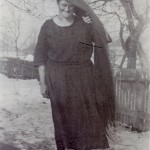by
Larry & Susan Pearce
11/20/17
Return to Part I: Our Families’ Faith Journey
Return to Part II: A Short History of the Reformation
Return to Part III: A Summary of our Recent Anabaptist Heritage Tour
Introduction
This is the fourth and final part of the article celebrating the Protestant Reformation that many believe began with the posting of Roman Catholic priest and professor Martin Luther’s “95 Theses” on the door of the Wittenberg Castle in 1517. We now know that the movement began many years before that. In providing some context here, we started with a brief look at the faith journey of my wife Susan and me, mostly consisting of Lutheranism, Presbyterianism, and Methodism. In the second part we considered the history of the Protestant Reformation, and in the third, we placed the Reformation, particularly as it played out among her Anabaptist ancestors, in a heritage tour we took to Germany, Switzerland, and France earlier this year. Finally, this part looks more deeply into the Amish, as they migrated from what is called the “world’s oldest democracy,” Switzerland, to the world’s freest, America. According to internet author David Biden, “Almost everyone knows about the Amish.” I began to research this article thinking that I could simply transcribe his online article, “26 Amish Facts You Need to Know, because it was so simple and concise. I e-mailed the commercial SportingZ site to ask permission, but never heard from them. As my research continued, I found other similar sites by different authors, some containing a repeat of Biden’s information. After I stumbled on a recent article in USA Today, I realized that the Amish must be a very popular topic and that my readers could be best served by comparing what popular authors claim to what scholar John A. Hostetler has to say in his seminal work, Amish Society. He summarizes as follows:
According to internet author David Biden, “Almost everyone knows about the Amish.” I began to research this article thinking that I could simply transcribe his online article, “26 Amish Facts You Need to Know, because it was so simple and concise. I e-mailed the commercial SportingZ site to ask permission, but never heard from them. As my research continued, I found other similar sites by different authors, some containing a repeat of Biden’s information. After I stumbled on a recent article in USA Today, I realized that the Amish must be a very popular topic and that my readers could be best served by comparing what popular authors claim to what scholar John A. Hostetler has to say in his seminal work, Amish Society. He summarizes as follows:
It’s a satisfying society, close to nature, full of security, in which the individual has a sense of belonging to the group from the time he is born until he dies. But there is a price for this security. It’s absolute conformity to the group, with the ministers and bishops calling the tune.
What follows are some basic facts about and beliefs and practices of the Amish that will help us all appreciate their culture and community. First, I should say that my wife Susan’s paternal grandmother Baer came from an old European line and represents the most religious diversity imaginable, mostly through marriage, over eight generations: Amish, Mennonite, Church of the Brethren, Lutheran, Presbyterian, and Methodist. Susan’s maternal grandmother, Annie Lee Krause (1885-1971)(pictured above), was born and raised Amish in southern Somerset County, PA. She married Susan’s grandfather, Charles Frederick Krause (1884-1973), a nearby Lutheran, and left the religion. Ironically, later in their marriage, Charles moved his family north to what was called “The Presbyterian Farm,” now Pine Springs Camp in Jennerstown, where he was the manager. We still visit and associate with “Mom” Krause’s Amish relatives and neighbors. Of course, as I pointed out in Part I, Susan and my religious heritage is rich an varied, and the purpose of this section is to have you see how far from Susan’s Amish ancestors, geographically, theologically, and culturally we alone, as a couple, have come. The purpose of this article is not to persuade theologically, but rather to inform. I can’t speak for, because I don’t know, all of Susan’s Amish-associated families, but at last count there were nearly two dozen. I’ll base some facts, yes, and myths, in what I know about these Amish ancestors, with links in the appropriate places to other websites, references to other articles I’ve written, and always when possible, a list of my documentation in the Works Cited.
While the vast majority of Amish live in the U.S., and none remaining in Europe, a few are now migrating to South America to escape the modernization and over-crowding of America. Here in Pennsylvania, where they first settled after being asked to leave their homelands in Switzerland, Germany, and France, we mostly take them for granted and leave them alone, except to treat them as a tourist attraction. According to the Lancaster, PA, Chamber of Commerce, millions of visitors flock there each year, leaving hundreds of millions of dollars behind for the local economy. More and more the Amish work in industries other than farming. Still, they, in their primitive practices, can seem very foreign. What follows is a categorical description of our Amish, their history, beliefs, and every-day activities.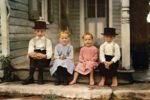 History of Our Amish in Europe and America
History of Our Amish in Europe and America
As we said in Part II of this article, a more detailed account of the Protestant Reformation, questions as to the beliefs and practices of the Roman Catholic Church probably began with men who are now declared saints: Augustine, Jerome, and Francis. In 16th century Europe, some Protestant reformers who had begun as Roman Catholic priests simply wished to make a few changes in the Church, certainly without starting a new one. Martin Luther (1483-1546), for example, is well known, but his complaints against the Catholic State were not the first nor the last. As we outlined simply, in Part II, there were John Wycliffe (c.1320-1384) and Henry VIII’s (1491-1547) English Revolution, John Hus’ (1369-1415) Moravian-Czech Revolution, and John Calvin’s (1509-1564) French-Swiss Revolution, to name a few. The English rebellions begat the Anglican and Methodist institutions. Luther’s followers went on to found the Lutheran Church. Calvin’s doctrines found their way to Scotland and John Knox’s (1513-1572) Presbyterian movement. The Moravians, the Hussites, and Hutterites, and others, were sects that came out of Central Europe. Menno Simons (1492-1561), of Holland, was not the scholarly debater as Luther was, but after he left the Roman Catholic Church in 1536, he exerted his gentle influence on the Anabaptists of Switzerland, Germany, France, and the lowlands, who were also in conflict with the Holy Roman Empire and Reformed States. Simons and his followers, later called Mennonites, believe that baptism should take place after a person reaches the age of accountability, as opposed to the prevailing practice of infant baptism. Furthermore, they rejected the use of military force to solve political problems. In 1568, Anabaptist ministers met in Strasbourg, France, to vote on new rules for the movement, including the wearing of plain attire.
Jakob Ammann (1644-after 1712), baptized in the Reformed Church, was converted and became an Elder in the Anabaptist movement after moving to Alsace, France. He broke from the kinder Mennonites in 1693 and further “forsook the world.” His followers, called the Amish, opposed long hair on men, shaved beards, and clothing that manifested pride. Foot washing became part of the Lord’s Supper. Women were never to cut their hair. Excommunication awaited anyone who didn’t lead a pious, penitent life. “Husli Hans” Reist, a senior Swiss Anabaptist elder from Zaziwil, boycotted a meeting called by Ammann on shunning (meidung), or ignoring to the point of ex-communication those who had broken the Church ordinances (ordnung). Other bishops showed interest in this practice. Amman accused Reist publicly of being a “plotter” and insisted he be the first to be ex-communicated. Furthermore, Ammann officially shunned all who didn’t agree. By 1700, Amman had reconsidered is position and wrote a letter admitting that he was wrong and apologized, but Reist resisted, the schism was too deep by then, and the division was permanent. Reist’s followers were known as the Emmental Party, after that region of Canton Bern. Amman’s stern teachings were rejected there, and today, after the assimilation of the EP back into the Swiss Brethren and the emigration of the Amish to America, there are no longer any followers of Ammann in Europe.
The ancestors of Susan’s first true Amish, her Great-great grandfather “Tommy” Lee having been “adopted,” included the Brennemans and Bender families of Hesse, Germany, and they didn’t begin as Amish either. The ancestors of these Amish probably had been exiled from Switzerland after they became Anabaptist-Brethren. Herman “Mannus” Bender was born about 1675, and Peter H. Brenneman more than a century earlier, about 1554, both before the Amish movement. But, Peter’s great-grandson was called Melchior “The Exile” or “The Refugee,” an indication of his status in the Reformed Church-State of that day.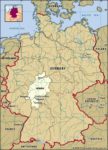 The large region of modern day Hesse, from where Melchior’s Great-great grandson Daniel and wife Maria Bender emigrated to America, extends from Heidelberg in the south to Kassel in the north with Frankfurt near the middle. This fertile land is northeast of the Rhineland-Palatinate, Germany, and Alsace, France, better known than Hesse for their accepting the Anabaptists of Switzerland. It should be noted that the State of Prussia once stretched from Belgium to Russia, it’s borders ever-changing with the countless wars on the continent. Of course, as we’ve said, the rich history of Susan’s Amish ancestors provides a great variety of names, dates, places, and stories to consider.
The large region of modern day Hesse, from where Melchior’s Great-great grandson Daniel and wife Maria Bender emigrated to America, extends from Heidelberg in the south to Kassel in the north with Frankfurt near the middle. This fertile land is northeast of the Rhineland-Palatinate, Germany, and Alsace, France, better known than Hesse for their accepting the Anabaptists of Switzerland. It should be noted that the State of Prussia once stretched from Belgium to Russia, it’s borders ever-changing with the countless wars on the continent. Of course, as we’ve said, the rich history of Susan’s Amish ancestors provides a great variety of names, dates, places, and stories to consider.
We promised in an earlier part of this article that we would offer the words to what is known as “The Haslibacher Song,” named for martyr Hans Haslibacher, a Swiss Anabaptist from Sumiswald, in the Emmental region, who was beheaded in 1571. Written in prison by an apparent witness, the 32-stanza poem was first bound to, not printed in, the 1614 Ausbund, or Amish hymn book. The book and song are still used in the American Amish church today. Somewhat graphic in detail, the song has come to represent the hardships and faith of Anabaptists everywhere: “The Haslibacher Song.”
By the mid-17th century, the Mennonites in the Netherlands were involved with their government in pressuring Bern to allow Anabaptists to leave Switzerland. Once in Holland, the Anabaptists were the center of a debate over whether they could be forced into exile. In the end, resettlement became voluntary and the term “emigration” was used. Some eventually were assimilated into Dutch culture, while others accepted an invitation to go to Prussia. But that same year, ten Swiss families set sail for America and settled on the Pequa Creek, Lancaster County. The following year Ulrich Schurch (1663-1739) of Sumiswald, Canton Bern, who had been imprisoned and exiled to the Palatinate, floated down the Rhine to Holland. He left for Philadelphia in 1728.
How did the Anabaptists gain acceptance in the New World in the first place? After the English king granted the Quaker Penn family a commonwealth in the New World, now known as Pennsylvania, or “Penn’s Woods,” to settle a debt he owed to the elder Penn, the younger William (1644-1718) made trips to the Palatinate region of Germany between 1671 and 1677 to find potential settlers. It was during this time that he invited the Anabaptists, the Mennonites, Brethren, and Amish, to settle in his new colony in the name of religious freedom. The first to take him up on this offer in 1683 was Franz Georg Pastorius and thirteen Anabaptist families. They founded Germantown, just north of Philadelphia. Even the Lutherans, who were also discriminated against by the German Catholics, were invited. Susan’s Great-grandfather Carl Ferdinand Krause (1840-1912) was just such an emigre from Prussia to Baltimore in 1871. How ironic that his son would marry an Amish Anabaptist in America years later.
It’s been said that the Amish, in particular, had been welcomed to France and Germany to have children and grow food, both at which they have always been particularly good, to resupply these nations after the 100 Years’ War and other conflicts. The truth is that for years Swiss mercenaries had provided bodies for all sides in European conflicts. But the Anabaptists refused to fight and were forced to leave their original home in supposedly neutral Switzerland when they wouldn’t enlist in the military, not to mention refusing to have their children baptized, even for census purposes, swear oaths, and, in some cases, pay taxes. The Anabaptists, along with the homeless (landsassen), were considered “undesirables.” Ironically, when the Swiss population began to dwindle in some areas, the government reconsidered and wanted them back, thinking maybe they could re-settle in the swampy areas of Canton Bern. But it was too late. The mass migration of the Anabaptists to more friendly Alsace-Lorraine, the Palatinate, the Netherlands, and even America had begun.
By 1800, few Anabaptists risked living in villages in Switzerland. Most relocated to highlands of the Emmental region, as described in Part III of this article, or to the other lands mentioned above. Eventually, after many imprisonments and much persecution, the Amish who hadn’t already been exiled, imprisoned, or executed, began to board the boats that would take them to the Netherlands and on to America. Landing in Philadelphia in the early 1700’s, and first settling in what was known as Germantown, they made claims to the rich farm land farther west in Berks and Lancaster Counties. The Quaker government in Philadelphia was pleased that the peace-loving Anabaptists could get along with the original settlers, the Indians, who themselves were slowly abandoning these lands for better hunting grounds beyond the Appalachians.
Many things Amish have not changed in the over 300 years since Jacob Ammann broke from the Anabaptist Mennonites. Elders of the local Amish church still engage in the biblical practice of casting lots in the election of their bishop, who in turn sets the standard practices of that community, whether it be the prohibition of modern technology such as telephones, electricity and motorized commercial enterprise or who gets shunned. Today, some Amish still remain in Eastern Pennsylvania in places like Lancaster County, but Berks county, home of many of my wife Susan’s ancestors, has been mostly devoid of the Anabaptists since the American Revolutionary War. In addition to their reluctance to fight, many were conflicted as to their allegiance. Remember that they had to vow good faith to the English King just to get into the colonies in the first place. But furthermore, the horrors of Indian raids such as the Hochstetler Massacre in 1757 drove them to reconsider living in such remote places. After the Peace Treaty of Fort Stanwix in 1784 many farmers of the East followed the Forbes Road to Somerset County and Western Pennsylvania. Most of my wife’s and my associated families climbed the Allegheny Mountains in hopes of finding a better life.
Today, America’s Amish fall into four or more main groups: Old Order, most conservative, such as the Swartzentruber Amish; New Order, often accepting newer conveniences; Beachy Amish, found in Somerset County, PA, the second oldest community in the U.S.; and Amish-Mennonites, an amalgamation of sects and denominations. But, let’s return to the descriptions of our Amish brothers and sisters as we might picture them. Using some of David Biden’s words as a framework for our discussion, we’ll also include a few details from other experts. By the way, do check back from time to time because I expect to be corrected and/or add new understandings and practices to this list. My wife Susan has been adding some interesting details, not only from her family experiences with her Amish friends and relatives but also her love of historical fiction by writers such as Ervin R. Stutzman and Beverly Lewis. In checking the internet for any books on the Amish, fiction or non, I found hundreds of books by dozens of authors. It all makes for a fascinating discussion. Unfortunately, some people have taken advantage of the plain folk and produced TV fare of a sometimes salacious nature, such as Breaking Amish and Amish Mafia. Fortunately, the internet is providing information on our Amish that is both interesting and factual. We suggest that you subscribe to Amish America by Erik Wesner or bookmark the Amish Online Encyclopedia. Also, you can’t do better than Google the name Bill Coleman (1925-2014) and look at the photos taken by a man who dedicated his life to showing us the Amish up close. For now, let’s look at a few facts about our Amish by categories.
Populations, Language, and Civic Duties
Although the Amish are often referred to as “Pennsylvania Dutch,” that’s a corruption of the word for German in German, or “Deutsch.” The Amish around the world speak one of many German dialects still found in Europe adapted to their community. Still evolving, their “Dutch” is continuously being influenced by surrounding English. One scholar claims that the Amish in the state of Indiana sound like Swiss-Germans. A quick search of the internet will reveal several Pennsylvania Dutch dictionaries.
The Amish are found in 30 states and Canada, with the largest populations in Ohio, Pennsylvania, and Indiana. One of the fastest growing groups in America, they may now be found in southern states like Mississippi where farmland is abundant and the weather cooperative. One estimate is that there are over 300,000 Amish in America today, more than tripling in the last 30 years. The Amish do not proselytize and there are few converts into the faith. but having large families is promoted and practical because of the great need in farming. Though marriages between more distant relatives is not unusual, first-cousin relationships are discouraged. Genetic testing is unheard of because of the belief that God ordains love. Still some physical and mental illness, disease, and disabilities occur within what we would call “inbreeding practices.” On the bright side, science is studying this small, stable, and historically close-knit culture in understanding and treating such maladies.
Many younger Amish are now supplementing farm income with construction labor and manufacturing. I’ve seen Amish greenhouses and auction sites in Somerset County, PA, and String Town, Iowa. Much furniture and recreational vehicles now are made by the Amish in the state of Indiana. These industrious folks are almost always behind the counter at the roadside markets, but be careful. Just because the sign says “Amish” doesn’t mean that the goods are genuine. And yes, the Amish do pay taxes: income, property, sales, estate, corporate, and school. One advocate reminds us that some pay school taxes twice – once for public and another for their private schools. In 1965 Congress officially exempted the Amish from paying or collecting Social Security, Medicare, and Workman’s Comp. These programs are in the same category as commercial insurance. The Amish believe that, according to the Bible and 1st century Christian practices, their fellow Amish are responsible for help in emergencies, although most Amish avail themselves of modern medicine and medical services as nothing in the Bible suggests otherwise.
In 1965 Congress officially exempted the Amish from paying or collecting Social Security, Medicare, and Workman’s Comp. These programs are in the same category as commercial insurance. The Amish believe that, according to the Bible and 1st century Christian practices, their fellow Amish are responsible for help in emergencies, although most Amish avail themselves of modern medicine and medical services as nothing in the Bible suggests otherwise.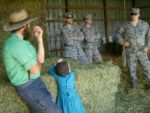 As we said before, the Amish are excused from service in the military, based on their belief in “non-resistance.” This extends to the need for police and lawyers. Historically, most Anabaptists seek alternative service during wartime. While they obey all laws, they don’t vote in local or national elections either.
As we said before, the Amish are excused from service in the military, based on their belief in “non-resistance.” This extends to the need for police and lawyers. Historically, most Anabaptists seek alternative service during wartime. While they obey all laws, they don’t vote in local or national elections either.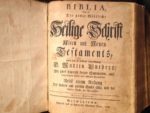 The English
The English
Regardless of what a person’s nationality or ethnicity might be, the Amish refer to all people outside their faith simply as “English,” stemming from their first contacts in the New World, despite the high number of other German-speakers in Pennsylvania. This pertains to attire, grooming, and even speech, although the Amish usually reserve Pennsylvania Dutch and its unique expressions for discourse among themselves. High German, however is used in church in scripture readings and sermons.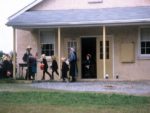 Schooling
Schooling
Eighth grade is as far as their education goes, and it’s all legal now. Young learners can be excused earlier for “vocational training,” which might include an apprenticeship in a trade or farming with the family. Teachers usually come from the community and have little formal training. Low-Tech
Low-Tech
The Amish are very limited in their use of technology; the most conservative sects almost entirely shun electricity. The reason for this unusual lifestyle is a philosophical and religious belief called “Gelassenheit”, which translates closely to “letting-be” – The belief that the earth should be left as close to as how God created it. While technology is not believed to be evil in itself, it can be a distraction from a more natural life. Modern conveniences can be a temptation away from traditional ways. Ironically, sources as powerful as a 12-volt car battery are permitted, but Amish are only permitted to ride in cars, not drive them. Telephones are not permitted in their homes, but they may use an “English” neighbor’s, or the phone company often installs such a communication device in a booth central to the community. While Amish don’t use mirrors because such attention to image is thought of as sinful, contrary to popular belief, an Amish adult can give permission to be photographed, but they don’t like the practice. To them, such media are “graven images,” generally prohibited as given to pride and vanity. Group pictures in a natural setting are acceptable, especially if the faces are turned or not shown.
While Amish don’t use mirrors because such attention to image is thought of as sinful, contrary to popular belief, an Amish adult can give permission to be photographed, but they don’t like the practice. To them, such media are “graven images,” generally prohibited as given to pride and vanity. Group pictures in a natural setting are acceptable, especially if the faces are turned or not shown. Bearded Men
Bearded Men
Amish men are well known for their long beards, but why no Mustache? The reason: back in the 1800’s, mustaches were considered to be a fashionable statement for the wealthy and for the military – both of which the Amish highly disapprove. This applies only to married men. Single men are permitted to shave. Going with “Gelassenheit,” women are not permitted to cut their hair or shave at all.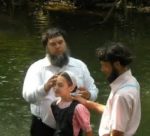 Believer’s Baptism
Believer’s Baptism
The Amish are a Christian sub-sect called Anabaptist. Among many things, this means that they believe the practice of “believer’s baptism,” or being baptized only after making a public profession of acceptance of Jesus Christ as Savior. Those who wish to become full members of the church must be old enough to independently state their faith, usually between the ages of 16 and 24, which means that infants are not baptized.
Keeping Order
Separate from the Bible, the Ordnung (meaning “order”) is basically “Amish 101.” It’s a list of rules of conduct for everyday life, formulated especially for the Amish from tradition and augmented by the local bishop. Breaking the Ordnung can land one in serious trouble, or shunning (meidung). Only an apology can bring about forgiveness and restoration. If history is an indicator, even crimes can be pardoned by the community. Rhumshpringa
Rhumshpringa
Because baptism into the Amish church must be one’s own decision as an adult, between the ages of 14 to 18, many young people spend a period experimenting with life outside of the Amish community. This custom is called “rumshpringa” and can be translated to English roughly as “running around.” Hochstetler calls this “an outlet for teen-age friskiness.” During Rumschpringa, Amish youths experiment with everything the “English” world has to offer that they are otherwise denied. When boys reach dating age, around 16, their parents often provide them with their own horse and buggy. Incidentally, it’s been said that the automobile is the greatest attraction and temptation for Amish youth today. It’s not unheard of for some to “borrow” and/or hide cars away during this time. In fact, some groups who have broken away from the Old Order actually use them in public. They’re referred to as “Automobile Amish.” But cars and girls are not the only temptations the young Amish men face. Teen-agers sometimes have what we might call today, “gangs.” One source reveals that Lancaster County has as many as a dozen, ranging from “pious,” called the “Lemons,” to “rowdy,” who affectionately refer to themselves as “Insects.” The real hell-raisers are known as “The Shotguns,” who may wear “English” clothes and hang out in bars. They often become ex-Amish unless they court a stricter Amish girl who “straightens them out.”
But cars and girls are not the only temptations the young Amish men face. Teen-agers sometimes have what we might call today, “gangs.” One source reveals that Lancaster County has as many as a dozen, ranging from “pious,” called the “Lemons,” to “rowdy,” who affectionately refer to themselves as “Insects.” The real hell-raisers are known as “The Shotguns,” who may wear “English” clothes and hang out in bars. They often become ex-Amish unless they court a stricter Amish girl who “straightens them out.” While some do decide to leave the church, at the end of the day the vast majority, 80% of teens, even the most rebellious, return to their communities to be baptized into the faith and are married soon after. Some teens only spend a week or so outside the community before getting baptized, and do little more that maybe try smoking a cigarette. Others venture much further into the world, sometimes for years.
While some do decide to leave the church, at the end of the day the vast majority, 80% of teens, even the most rebellious, return to their communities to be baptized into the faith and are married soon after. Some teens only spend a week or so outside the community before getting baptized, and do little more that maybe try smoking a cigarette. Others venture much further into the world, sometimes for years. Dating Amish
Dating Amish
Contrary to what many people would think, marriage among the Amish is never arranged. Young people meet in public settings, and if a couple decides to “go steady,” they have more private dates, usually sharing hot chocolate or a soda and going on buggy rides. This actually sound pretty romantic. Bundling
Bundling
A common part of courtship for young couples is to actually spend the night in bed together (fully clothed, of course), and basically stay up talking. This is practical for trips to relatives far away before they are married. This practice seems surprising for such a conservative culture.
Engagement
Once a couple decides to get married (which doesn’t usually take too long), they get their engagement blessed by their bishop and the banns are announced in church, you know, “If anyone knows of any reason why . . . “ But first, the minister, specifically a “Schtechleimann,” or go-between, secretly contacts the girl’s parents for consent. After that, a formal declaration is put out in the town newspaper. Marriage
Marriage
Couples are only allowed to wed after they have been baptized into the faith. Weddings are usually held after the harvest season in the fall, and the ceremony can last for hours. The bride wears a simple blue-linen dress, which she is expected to sew herself. She may wear this to church the rest of her life. The Ordnung prohibits that she wear makeup or an engagement ring, as they are considered representations of vanity. The ritual is so modest that celery is often used instead of flowers. Honeymoon
Honeymoon
The couple usually travels after the wedding to visit friends and relatives in the community and beyond for several weeks. Most of the wedding gifts are given at this time and are very practical, part of the new household that has been established.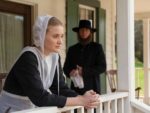 Women’s Roles
Women’s Roles
Married females are pretty much relegated to a biblical station in life: cooking, cleaning, sewing, and most importantly, raising children. They must follow the husband’s rules and cannot serve as preachers or bishops in the church. The good thing is that they fellowship with other married women in the community, where they get both emotional and physical support and encouragement. Sharing is Caring
Sharing is Caring
For the Amish, meals are an integral part of community and social life. On many occasions, meals are served as community potlucks, with everyone bringing something to a large table at the town’s center. This is a chance not just to eat, but for the women to speak, the men to discuss, and for the young people to mingle in a supervised environment. Perhaps the most festive occasions include quilting bees, “schnitzing,” or apple peeling, corn shucking, and barn raisings, times when the community comes together for the good of a particular family in times of harvest or loss.
Shunning
“Meidung,” or the practice of avoiding any community member who broke the rules was the first and permanent disagreement between co-founder Jacob Ammann and William Reist back in Europe. As we said in Part II, Ammann later apologized, but it was too late for reconciliation. My wife’s grandmother Annie Lee was never shunned by her Somerset County congregation after she married a Lutheran as young woman, probably because she made that division before being baptized into their faith. In fact, all of the community we’ve ever talked to spoke kindly of her. Some even attended her Lutheran funeral.
The Unusual Some things among their practices may go unnoticed by the outside world. For example, did you know that Amish dolls are faceless. This purposefully deters against pride and vanity, traits of character fostered from little up.
Some things among their practices may go unnoticed by the outside world. For example, did you know that Amish dolls are faceless. This purposefully deters against pride and vanity, traits of character fostered from little up.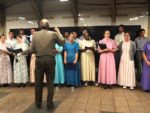 All music, such as songs and hymns, are performed without accompaniment, or “acapella.” They believe that playing instruments encourages feelings of superiority.
All music, such as songs and hymns, are performed without accompaniment, or “acapella.” They believe that playing instruments encourages feelings of superiority.
In the Amish tradition, the youngest son inherits the farm, the property, and the parents’ assets. Going against biblical principles where the eldest gets the prize, the only explanation might be that by the time the youngest is ready to take over for the father, the older brothers have already moved out to acquire property of their own. Jewelry is not worn by women, nor belts by men. Adult women wear their never-been-cut hair in a braid or a bun, covered by a bonnet or prayer cap when in public. Men wear suspenders. All conservative Amish must avoid velcro and zippers, but instead use straight pins or mechanical hooks and eyes rather than buttons for fastening to avoid looking vain and fancy.
Jewelry is not worn by women, nor belts by men. Adult women wear their never-been-cut hair in a braid or a bun, covered by a bonnet or prayer cap when in public. Men wear suspenders. All conservative Amish must avoid velcro and zippers, but instead use straight pins or mechanical hooks and eyes rather than buttons for fastening to avoid looking vain and fancy. Pow-wow (“Braucherei”), or folk medicine, has sometimes been practiced among the Amish. The term takes in a wide range of healing rituals for ailing humans and livestock. It’s understood that such activities also secure spiritual protection and “good luck.” Many of these Anabaptist ideas existed pre-Reformation in Europe, so no doubt these folk religious activities originated in or before Medieval times, perhaps from the Catholic rite of exorcism. The term “Pow-wow” is Native American Algonquian for “healer,” with implications of a trance or dream. The English had their own version called “Cunning Craft.” Specific words and actions used by the Amish come from an 1820 manual by John George Hohman, Pow-wows: The Long Hidden Friend. Yet, the Bible is the main power here, and the practitioner, or “Hex Doctor,” always had one in his hands. Apparently, the source of his instruction was the Old Testament Pentateuch, or five book of Moses.
Pow-wow (“Braucherei”), or folk medicine, has sometimes been practiced among the Amish. The term takes in a wide range of healing rituals for ailing humans and livestock. It’s understood that such activities also secure spiritual protection and “good luck.” Many of these Anabaptist ideas existed pre-Reformation in Europe, so no doubt these folk religious activities originated in or before Medieval times, perhaps from the Catholic rite of exorcism. The term “Pow-wow” is Native American Algonquian for “healer,” with implications of a trance or dream. The English had their own version called “Cunning Craft.” Specific words and actions used by the Amish come from an 1820 manual by John George Hohman, Pow-wows: The Long Hidden Friend. Yet, the Bible is the main power here, and the practitioner, or “Hex Doctor,” always had one in his hands. Apparently, the source of his instruction was the Old Testament Pentateuch, or five book of Moses.
Some of the ailments cured include bleeding, headaches, bruises, and burns, to name a few. A specific example of treatment is described under “A good remedy for those who cannot keep their water” and instructs: “Burn a hog’s bladder to powder and take it inwardly.” While modern folk probably think this is superstition, the hex doctor has always seen himself as more of a mediator between man and heaven than a doctor, fervently calling on prayer and scripture. A fee is never charged or it will diminish the effectiveness of the cure. The pow-wower, as he is called, has to be at least 30-years old, a person of common sense, loved by all, and in good health. Any personal weaknesses will, again, diminish the cure. A person can only learn pow-wow through someone of the opposite sex. This is called “crossways,” probably after the natural order of procreation. A variation of this is recalled by my wife, who says her grandfather, who was German Lutheran and not Amish, offered to “buy” a wart from her hand. He claimed that only a male could heal a female and vice-versa. Interestingly enough, a nickel was exchanged and in a few days, the wart was gone. Incidentally Grandpa Miller’s wife Sarah, also a descendant of the Amish, did not approve of his pow-wows.
The Bible urges all Christians to be “in the world, but not of it.” The Amish go far beyond, calling the American way of life “The Devil’s Playground,” full of worldly temptations. They’re not putting us English down; this is simply a way to label what they wish to avoid.
Conclusion
One thing is for sure about the Amish: They are a modest bunch of people. They will never condemn you for having another religion as they believe that arrogance is a sin. While there are as many practices, avoidances, prohibitions, and cautions as there are Amish communities in the world, their aim is to please God and obey his commandments. My wife and I feel that we have been blessed to have ancestors in that faith, have been able to travel to the lands from which they came, and keep in touch with those whom we consider friends in the Amish community. We visit regularly with them, especially through our membership in the Casselman Historians, Grantsville, MD, and research through the Springs Historical Society, Salisbury, PA. As I said in the introduction, I’ll be editing, expanding, and correcting this final part on the Amish as I seek additional information from various groups around the country. Meanwhile, you are invited to read some or all of the articles referred to below for a fuller understanding of our experiences, and by all means, take in the knowledge of the experts in the Works Cited section. Your comments are coveted in the space below. Guten tag!
OTHER ARTICLES ON AMISH FAITH & CULTURE FROM E-GEN. INFO
(all by Larry Pearce unless otherwise indicated)
“A Vacation Back to the Future: From Michigan to Iowa.”
“European Backgrounds of the PA Dutch” by A. Monroe Aurand
“Three General German Immigration Periods,” by A. Monroe Aurand and “Commentary,” by Larry Pearce
“A Journey between two Passages: The “Mom” & “Pop” Krause family
from the National Road to the Lincoln Highway”
“Meet Cousin Christian ‘Schmidt’ Miller”
“Our Hannes ‘Indian John’ Miller”
“Meet our Great-great-grandfather Thomas ‘Tommy’ Lee
“Swiss Anabaptist Genealogical Association (SAGA) 2017 Meeting.” Mennonite Family History, Oct. 2017
https://e-gen.info/?page_id=7729
WORKS CITED
“Amish.” Wikipedia.org.
https://en.wikipedia.org/wiki/Amish
“Jakob Ammann.” Wikipedia.org. 7 December 2016
https://en.wikipedia.org/wiki/Jakob_Ammann
David Biden. SportingZ. “26 Amish Facts You Need to Know.” 10 July 2016.
http://www.sportingz.com/news/26-amish-facts-need-know/?utm_campaign=Amish%20Facts%20SP-%20Desktop%20OB&utm_source=Outbrain&utm_medium=1768120&utm_content=65368277&utm_term=26+Amish+Facts+You+Need+to+Know
Simon Bronner & Joshua Brown, eds. Pennsylvania Germans: An Interpretive Encyclopedia. Baltimore: Johns Hopkins University Press, 2017
Matthew Diebel. “The Amish: 10 Things You Might Not Know.” USA Today. 16 August 2016.
http://www.usatoday.com/story/news/nation/2014/08/15/amish-ten-things-you-need-to-know/14111249/
John A. Hostetler. Amish Society. Baltimore: Johns Hopkins University Press, 1980
“Menno Simons.” Wikipedia.org. 7 December 2016
https://en.wikipedia.org/wiki/Menno_Simons
“Pow-wow (folk magic). Wikipedia.org. 17 August 2017
http://en.wikipedia.org/wiki/Pow-wow_(folk_magic)
“The Amish Keep These Details Hidden for a Good Reason.” Mozo Travel. 12 September 2016.
http://mozotravel.com/2016/09/12/the-amish-keep-these-details-hidden-for-a-good-reason/1/
“The Origin and Practice of Pow-wow Among the Pennsylvania Germans. Berks History Center. 17 August 2017
http://www.berkshistory.org/multimedia/articles/pow-wow/
“The Unyielding Amish.” Magazine article (source & date unknown)
“William Penn.” Wikipedia.org. 7 December 2016.
https://en.wikipedia.org/wiki/William_Penn
Cherie Winner. “Not just the Amish: Pennsylvania Germans in American Culture,” Research/Penn State magazine, 8 July 17
Various oral and written sources found on E-Gen pages from Krause, Brennemen, Lee, Bender and associated Amish families
https://e-gen.info
Return to Part I: Our Families’ Faith Journey
Return to Part II: A Short History of the Reformation
Return to Part III: A Summary of our Recent Anabaptist Heritage Tour
Last revised 11/29/17

